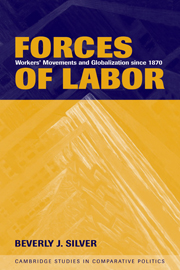Book contents
- Frontmatter
- Contents
- List of Figures
- List of Tables
- Preface and Acknowledgments
- 1 INTRODUCTION
- 2 LABOR MOVEMENTS AND CAPITAL MOBILITY
- 3 LABOR MOVEMENTS AND PRODUCT CYCLES
- 4 LABOR MOVEMENTS AND WORLD POLITICS
- 5 CONTEMPORARY DYNAMICS IN WORLD-HISTORICAL PERSPECTIVE
- Appendix A The World Labor Group Database: Conceptualization, Measurement, and Data Collection Procedures
- Appendix B Instructions for Recording Data from Indexes
- Appendix C Country Classifications
- References
- Index
- Cambridge Studies in Comparative Politics
5 - CONTEMPORARY DYNAMICS IN WORLD-HISTORICAL PERSPECTIVE
Published online by Cambridge University Press: 05 June 2012
- Frontmatter
- Contents
- List of Figures
- List of Tables
- Preface and Acknowledgments
- 1 INTRODUCTION
- 2 LABOR MOVEMENTS AND CAPITAL MOBILITY
- 3 LABOR MOVEMENTS AND PRODUCT CYCLES
- 4 LABOR MOVEMENTS AND WORLD POLITICS
- 5 CONTEMPORARY DYNAMICS IN WORLD-HISTORICAL PERSPECTIVE
- Appendix A The World Labor Group Database: Conceptualization, Measurement, and Data Collection Procedures
- Appendix B Instructions for Recording Data from Indexes
- Appendix C Country Classifications
- References
- Index
- Cambridge Studies in Comparative Politics
Summary
Our premise at the start of this book was that, by recasting labor studies in a world-historical framework, we would be able to shed a new light on the contemporary global crisis of labor movements. The central chapters of the book sought to distinguish, from successive angles of vision, dynamics that are recurrent from those that are fundamentally new and unprecedented in the trajectory of world labor unrest. This final chapter returns to the debates highlighted in Chapter 1 about the causes, depth, and nature of the contemporary crisis of labor movements, informed now by our study of the past.
A Race to the Bottom?
Our analysis of the globalization of mass production in the world automobile industry in Chapter 2 concluded that the geographical relocation of production has not created a simple race to the bottom. Rather, we found a recurrent pattern in which the geographical relocation of production tended to create and strengthen new working classes in each favored new site of investment. While multinational capital was attracted by the promise of cheap and controllable labor, the transformations wrought by the expansion of the industry also transformed the balance of class forces. The strong labor movements that emerged succeeded in raising wages, improving working conditions, and strengthening workers' rights. Moreover, they often played a leading role in democracy movements, pushing onto the agenda social transformations that went well beyond those envisioned by pro-democracy elites.
To be sure, the relocation of capital from existing sites of production tended to weaken established working classes.
- Type
- Chapter
- Information
- Forces of LaborWorkers' Movements and Globalization Since 1870, pp. 168 - 180Publisher: Cambridge University PressPrint publication year: 2003
- 1
- Cited by



